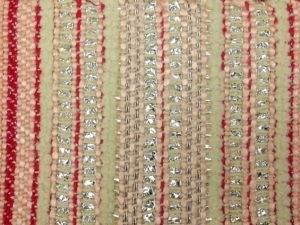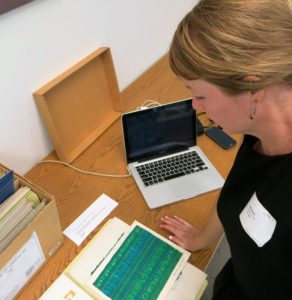The Metallic Fiber Designs of Dorothy Liebes
EMERGING SCHOLARS > SUMMER RESEARCH GRANTS
By SARAH MILLS,
Department of Art History, City University of New York
This summer I pored over numberous swatches woven by Dorothy Liebes, now housed at the Smithsonian Institute’s Archives of American Art in Washington, DC, a trip made possible by the generous support of the Decorative Arts Trust. My dissertation, “Craft Consciousness: Modern Weaving in the United States, 1935–1956,” examines how a mid-20th-century wave of industrialization in the textile field and the professionalization of weavers working in industrial design impacted the form and meaning of woven objects. My research at the Archives allowed me to grasp the full extent of Liebes’ experimental studies with modern fibers intended for automobile upholstery, wall covering, and window drapery.
I focused predominantly on Liebes’ work with synthetic threads, particularly metallic varieties known by the brand names Lurex and Fairtex. If you bought a shimmering interior fabric in the 1950s in the United States, there is a good chance that you bought a Liebes design. In 1946, the Dobeckmun Company, which was the first to make modern metallic threads, hired her to test their new Lurex fiber in woven swatches and samples. Dobeckmun, under the guidance and sole direction of Liebes, then mass produced specific designs for a mainstream textile market. She was trained in a hand weaving tradition and highly regarded for her expertise in the technical side of the production as well as an authority on style. Liebes held contracts with multiple manufacturing companies, thereby providing access to an enormous range of natural and innovative artificial fibers. Between the 1940s and the late 1950s, she eagerly experimented with metallic threads.
The structure and diversity of Liebes’ weaving studies suggest she analyzed color relationships, densities, textures, and performance capabilities. For instance, she built charts based on graduated thicknesses of yarns. She also designed grids where in each cube a multitude of threads reveal a range of value for one specific hue. More elaborate studies occurred on the loom. The differences in texture and density in woven swatches underscore Liebes’ concerns with the function and effectiveness of fabrics.
The strong mirror-like reflectivity of metallic threads gave Liebes the freedom to play with spatial illusions. Where she used thin metallic threads sparsely as weft with thicker, fuzzier natural yarns as warp, she created highlights in swatches with considerable impressions of depth. Light quickly dashes across the smooth gilt-like surfaces of a fabric with metallic thread enhancing the sculptural quality of the material’s form. Liebes’ use of metallic threads for weft and warp also indicates her interests in testing their durability for the rigorous applications for which they were intended.
My insights of Liebes’ weaving studies could not have been possible without observing her fabrics first hand. I am grateful to the Decorative Arts Trust and the Marie & John Zimmermann Fund for their support. I look forward to sharing my research to broaden the understanding of mid-20th-century commercial weaving in the United States.
By SARAH MILLS,
Department of Art History, City University of New York
This summer I pored over numberous swatches woven by Dorothy Liebes, now housed at the Smithsonian Institute’s Archives of American Art in Washington, DC, a trip made possible by the generous support of the Decorative Arts Trust. My dissertation, “Craft Consciousness: Modern Weaving in the United States, 1935–1956,” examines how a mid-20th-century wave of industrialization in the textile field and the professionalization of weavers working in industrial design impacted the form and meaning of woven objects. My research at the Archives allowed me to grasp the full extent of Liebes’ experimental studies with modern fibers intended for automobile upholstery, wall covering, and window drapery.
I focused predominantly on Liebes’ work with synthetic threads, particularly metallic varieties known by the brand names Lurex and Fairtex. If you bought a shimmering interior fabric in the 1950s in the United States, there is a good chance that you bought a Liebes design. In 1946, the Dobeckmun Company, which was the first to make modern metallic threads, hired her to test their new Lurex fiber in woven swatches and samples. Dobeckmun, under the guidance and sole direction of Liebes, then mass produced specific designs for a mainstream textile market. She was trained in a hand weaving tradition and highly regarded for her expertise in the technical side of the production as well as an authority on style. Liebes held contracts with multiple manufacturing companies, thereby providing access to an enormous range of natural and innovative artificial fibers. Between the 1940s and the late 1950s, she eagerly experimented with metallic threads.
The structure and diversity of Liebes’ weaving studies suggest she analyzed color relationships, densities, textures, and performance capabilities. For instance, she built charts based on graduated thicknesses of yarns. She also designed grids where in each cube a multitude of threads reveal a range of value for one specific hue. More elaborate studies occurred on the loom. The differences in texture and density in woven swatches underscore Liebes’ concerns with the function and effectiveness of fabrics.
The strong mirror-like reflectivity of metallic threads gave Liebes the freedom to play with spatial illusions. Where she used thin metallic threads sparsely as weft with thicker, fuzzier natural yarns as warp, she created highlights in swatches with considerable impressions of depth. Light quickly dashes across the smooth gilt-like surfaces of a fabric with metallic thread enhancing the sculptural quality of the material’s form. Liebes’ use of metallic threads for weft and warp also indicates her interests in testing their durability for the rigorous applications for which they were intended.
My insights of Liebes’ weaving studies could not have been possible without observing her fabrics first hand. I am grateful to the Decorative Arts Trust and the Marie & John Zimmermann Fund for their support. I look forward to sharing my research to broaden the understanding of mid-20th-century commercial weaving in the United States.



